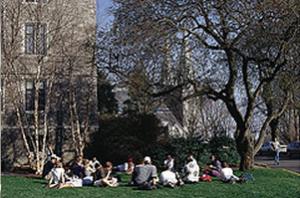- 3 reads

The year was 1957, and the Soviets had just fired Sputnik 1 into Earth orbit. Instead of panicking (eventually), the U.S. saw what had gotten the Soviet Union into space first and… well, did the equivalent of looking over somebody’s shoulder during a midterm; making their answer our own.
Next thing the country knew, math and physical science were being pushed on young students who had been learning shapes and colors the previous year. And with good reason; this was an age where Americans weren’t used to losing.
Today, the Space Race is long over; the Russians, far from our most feared adversaries. Though the questions are different, the answers have remained similar to those of a time when apple pie and baseball weren’t tainted by McDonalds and Mark McGwire.
The environment is now our challenge, one that we arranged ourselves, years ago, and did nothing to stop. We live in an age of accepting inevitability, rather than simply delaying it further. Once again, we find ourselves fighting a losing battle, but this time, instead of our nation’s pride, we risk the life of our entire planet; once again, we turn to our education system for an answer.
Second Nature
In 1993, a group of folks in Boston including Senator John Kerry, Teresa Heinz Kerry, Bruce Droste and Dr. Anthony D. Cortese, formed “Second Nature,” an institution designed to gently escort sustainability into the curriculum of every educational outlet.
Dr. Cortese, in his speech Mobilizing Higher Education for a Healthy, Just, and Sustainable Society, explains the need for placing a green blanket over every aspect of education, from the valuable degrees, like engineering, to the utterly useless, like film. The idea is to park sustainability front and center, and make it the focus from which all other disciplines will branch.
We don’t see ourselves as a part of nature, we see ourselves above it. And we’re not.
Second Nature’s philosophy is based on the idea that everything in nature is interconnected, and therefore, dependent on each other. By causing damage in one place, it is inevitably going to come back to bite us. So, how much damage to nature are we looking at in 2010?
Cortese explains in detail some of the horrifying stats that decorate our generation’s contributions to global environmental detriment, but I’ll save you some time: You don’t want to know.
He warns of the misplaced trust we have in things like the climate, which we assumed would stay the same, despite everything. We are at a point in history where everything we’ve done has been based on the stability of the weather: “The location of our cities and communities, agriculture, ports and other transportation, businesses and other human endeavors, in large part, has been based on the predictability of the climate.”
“Now,” Cortese writes, “all bets are off.”
Sustainability Degrees
Second Nature has put the wheels in motion to spark such changes. The ACUPCC, or American College and University Presidents’ Climate Commitment, was set up through Second Nature and several other foundations to organize schools and institutions across the country under the umbrella of sustainable education. The concept has yet to become widespread, but there are plenty of schools anxious to begin enrolling sustainability-conscious students, such as Villanova University, Philadelphia University, and the Rochester Institute of Technology. The university in Greensboro has also shown great interest in providing their students with a sustainable education.
Dr. Randy Weinstein has taken both his award-winning teaching ethics and personal interest in the topic to spearhead the program at Villanova.
“I’ve always been involved with it, ever since grad school,” Dr. Weinstein says of environmental work. “It’s always kind of been a part of me.”
A part of him that’s on the way to becoming a part of students at Villanova and its brand new Masters of Science in Sustainable Engineering degree program. With a Faculty Award for Innovative Teaching from Villanova under his belt, the good doctor is primed for the challenge of facing the current generation head on; utilizing the immersive technology that so heavily populates student life in his curriculum.
But all you really need is one look at his teaching philosophy to be sure he’s the right man for the job.
“In every class, you will be learning something and I will learn something new as well – this synergy is critical for success,” he writes.
This is the world in which Second Nature succeeds as well: The educating of the masses works as a wheel. We’ve got a lot to learn, and as long as it keeps spinning, then everybody’s doing their part. Dr. Weinstein and teachers like him will be at the forefront as sustainable education makes a sweep across the country.
“I think it already is,” he says. “You see the courses coming first, over the past two to four years. We (Villanova) were waiting until we had enough to bring in the degree.”
Meanwhile, the words of Dr. Cortese continue to cast a haunting shadow over a future that could suffer due to the lack of a clued-in populace:
“What we must do is make the impossible inevitable.”
These are words that, by definition, couldn’t be further away from each other. Coming years will show us, just as they did in the Space Race, how the strength of advancements in education can make a new brand of knowledge a universal norm. As we stand knee-deep in the results of decades of ignorance, it will quickly become impossible not to see sustainable education as a necessity; especially now, with so much more at stake than being the first country in outer space.
History has taught us that a change can be for the better.

